A clogged sewer is always an unpleasant occurrence that must be eliminated in a timely manner before the situation becomes critical (in this case, it is no longer possible to do without the help of emergency services). Therefore, if water begins to linger in the toilet, immediate action must be taken. The main cause of blockages is the accumulation of toilet paper in sewer pipes. You can dissolve it using effective means at hand.
- 2 Detergent compositions
- 3 Vinegar
- 4 Pepsi and Cola
Is it okay to throw toilet paper down the toilet?
If you have a centralized drainage and sewerage system, then the remaining toilet paper is washed out by a constant flow of water through pipes with a wide diameter (at least 100 mm) of an apartment building into a common collector. From a common collector, paper, together with feces, is pumped into city wastewater treatment plants by powerful pumps. Here it is separated from large fractions by grates and enters a settling tank, where it decomposes with the help of aerobic and anaerobic bacteria. It is bacteria that decompose toilet paper and its constituent cellulose with the help of enzymes they produce.
However, it is not recommended to throw paper in an apartment building, since improper installation or design of sewerage systems, incorrect installation of the toilet and connecting it to the riser, and the ingress of foreign objects may reduce the flow of water and cause blockages from toilet paper residues.
How long does it take for toilet paper to biodegrade?
Its decomposition period is a couple of months.
When should you absolutely not throw toilet paper down the toilet?
If the toilet is installed in a frequency house, where waste is discharged through an autonomous sewer system with a pipe diameter much narrower than the centralized sewer (at least 100 mm is needed), as a rule, the water saving mode is activated here, there may be many turns and bends of the pipe, low water pressure, which leads to clogging of the sewer with paper.
Once in the storage tank of the storage septic tank, it settles at the bottom and is not removed until the sewer truck arrives, where it then clogs the special pipes. machine and spending additional power to pump it out.
If your autonomous sewage system is not equipped with modern storage and purification equipment, where there are anaerobic and aerobic bacteria that decompose cellulose, then throwing toilet paper is prohibited.
Features of removing different types of contaminants
The choice of cleaning agent is largely determined by what specific substance caused the stain on the paper. For example, to remove oil traces, you first need to absorb fat, and in the fight against smudges from watercolor paints, the splitting of the color pigment comes to the fore.
How to remove oil traces?
You can get rid of oil marks on paper using such compounds and improvised means as:
Bread crumb . Roll the crumb of white bread into a small ball, lightly moisten it with warm water and wipe the contaminated surface with it until it becomes absolutely clean.- Salt. It is a first aid remedy for combating greasy stains not only on fabric, but also on paper.
The smaller its granules, the better. Sprinkle the stain with salt, cover it with a clean sheet of paper and iron it with a warm, but not hot, iron. - Chalk. It acts as an absorbent, absorbing fat from any surface. A single piece is crushed into powder using a mortar, sprinkled onto the stain and gently rubbed in a circular motion. After 10-20 minutes, shake off the chalk. If the stain remains, then repeat the procedure, but using an iron.
- Flour. It helps get rid of fresh traces of fat. It is used by analogy with other bulk substances.
- Turpentine. If a greasy stain gets on strong white paper, you can try to remove it with turpentine, which is applied to a cotton pad and gently wiped over the problem area.
This article will tell you how to remove oil stains from paper.
Watercolor
If a watercolor stain has dried out, you can try to dissolve it with water and lemon juice. Procedure:
- add juice squeezed from half a lemon to 100 ml of water;
- pour it into a spray bottle;
- spray the stain, blot it with a clean, dry cloth;
- repeat the procedure until completely cleansed.
You can deal with watercolor stains using ethyl alcohol. They moisten a cotton swab with it and gently blot the dirt. The tool must be constantly changed so that the cotton wool does not leave behind streaks.
If splashes of watercolor get on dense washable wallpaper, you can deal with them with a soap solution. It is prepared using dishwashing liquid or laundry soap. After treatment, the surface is washed with clean water.
From coffee
Accidentally spilled coffee can ruin not only a school notebook or book, but also an important document. To rehabilitate it, they use the following compounds:
Hydrogen peroxide . It can lighten coffee, making it almost invisible. Apply it with a cotton swab or sponge. After processing, allow the paper to dry naturally.- Ammonia . They treat the stain until it completely disappears, after which they wipe the area with a slightly damp cotton swab.
- Bleach. You can use oxygen bleach or White. Use them carefully. Only durable, thick and light paper can be processed.
If, in addition to liquid, coffee grounds get on the stain, you need to brush them off with a brush before the main treatment.
From the dirt
Dirty stains on paper can be removed using such improvised means as:
- Alcohol. A cotton pad is soaked in it and the problem area is wiped several times.
- Hydrogen peroxide . It is used in a similar way to alcohol.
- Laundry soap . Before use, it is crushed into shavings and diluted in a small amount of water. The resulting composition is used to treat the contaminated area. When the stain disappears, gently wipe the paper with a damp cloth. This method is suitable for dense material. A thin sheet will not withstand repeated contact with liquid.
If the stain is fresh, it can be removed with a regular napkin. First, the wet surface is blotted several times. When dirty marks stop imprinting on the napkin, place a clean sheet on top of the soiled document and put it away in a thick book for 10-12 hours. In the morning the stain should disappear.
Fingerprints
Fingerprints can be removed using hydrogen peroxide . It quickly dissolves various organic contaminants. After applying it to the paper it will appear. This is a natural reaction that should not be alarmed. When it's finished, the fingerprint should disappear.
Ammonia copes well with fingerprints. When working with this substance for the first time, you need to remember that it has a pungent odor, so you need to take care of ventilating the room in advance.
Soak a cotton swab in ammonia and gently treat the stain. After cleaning, there is no need to rinse off the substance; it will evaporate on its own within a few minutes.
Tea
You can remove traces of tea using such improvised means as:
lemon juice - if the paper is strong, use it in its pure form, soak a cotton swab in the juice and treat the problem area with light blotting movements, remove excess moisture with a paper napkin;- ammonia - it makes the dye molecules less durable, so they easily transfer to the material being processed;
- if the stain is fresh and has not yet dried, it is generously sprinkled with starch, covered with a clean sheet of paper, which is passed over with an iron several times; if necessary, the procedure can be repeated.
How to remove blood?
Blood quickly absorbs into the paper and dries, making it difficult to remove. Compositions such as:
- Liquid stain remover , for example Vanish. Soak a cotton pad with it and touch the stain several times with dipping movements. When the blood begins to transfer from the paper to the sponge, it is changed. You need to work with clean discs so that the stain does not spread or smear.
- Hydrogen peroxide . It destroys organic molecules, including blood. To get rid of minor stains, just a few drops of peroxide applied to a cotton swab are enough.
- Boiled egg . If the stain is fresh, you can roll it with a warm boiled egg without the shell.
Any liquid product should be applied not to paper, but to the instrument. This could be a brush, a cotton pad or a cotton swab.
Putty or corrector
The corrector is used to mask ink, but sometimes situations arise when it needs to be removed from the paper. As a rule, this is easy to do with the help of substances such as:
- Alcohol. A cotton swab is moistened with it, applied to the stain and left for about a minute. After this procedure, the putty layer can be easily removed with a wooden file or even a fingernail.
- Nail polish remover . It contains a solvent that softens the putty. It is used in the same way as alcohol.
- Glass cleaning liquid . It contains several active components that can soften the corrector. Irrigate a cotton swab with the liquid and apply it to the white mark for 10 seconds (if necessary, the exposure time can be increased). When the putty becomes soft, remove it with a ruler or toothpick.
Do not attempt to clean off dry concealer. Using sharp objects will cause the paper to tear.
How to unclog a toilet with paper
A clogged toilet with toilet paper in an apartment building can only occur in conjunction with other factors:
- Defects and defects in the drainage system of the toilet itself or improper installation of the sewer system;
- Getting other foreign objects into the toilet or sewer;
- Formation of limestone or urinary stones inside the toilet water seal.
Toilet paper clogs can only be cleared mechanically, since the paper does not completely dissolve and is not actively affected by chemicals.
You can try to clear a clogged toilet with paper:
- using a plunger
- a special cable for cleaning the toilet for
If you don’t have either of these on hand, you can remove the blockage using a folk method for those who are not squeamish. Take an old towel or large rag and put on rubber gloves. Twist the towel into a rope, and then bend it in half again, tying it with a rope. Place a rag into the drain hole and, using forward movements so that the rag covers the drain hole, clean the drain, pushing through the clog.
You can use available means for this purpose, for example, a mop or a stick, wrapping a rag around it and securing it firmly with a rope.
If the blockage is nearby, a small piece of wire with a hook at the end will help. Put on rubber gloves and try to remove paper or other objects that have fallen into the toilet by placing it on an improvised hook.
You can make a wire for cleaning a toilet from a clothes hanger. A wire from a hanger for cleaning a toilet.
Helpful information
Tips that will come in handy when removing stains from paper:
You need to start removing the stain immediately, the longer it stays on the surface of the paper, the deeper it is absorbed into the structure; dealing with an old stain is much more difficult than dealing with a fresh one;- you need to remove the stain from the edge to the center so as not to smear it over clean areas;
- if the stain was not removed the first time, the procedure can be repeated, but only after the paper has dried;
- To remove small stains, use a cotton swab; if the contamination is extensive, use a cotton pad;
- in order not to go beyond the boundaries of contaminants, they are outlined with a wax candle;
- Before you begin to remove stains from an important document, the selected product should be tested on a sheet of paper similar in structure to the original.
We use a plunger
Almost every housewife has this device. They clean not only toilets, but also bathrooms and sinks. How does it work?
Using a plunger, you need to create conditions in the pipes for water hammer. It is he who must dislodge the blockage, which will then be broken into components and washed into the sewer.
You need to take it in your hands and place the rubber part against the toilet drain hole. After this, you need to press hard on it several times. This is how you will be able to achieve your goal. After some work with the fixture, you need to turn on the flush.
Read on topic: How to use a plunger
Universal recipes
Dealing with stains on paper is difficult, since the material itself in most cases does not tolerate contact with any liquids well. The choice of product largely depends on what exactly the sheet was stained with. However, there are also universal substances that can cope with various types of pollution. Top 5 effective recipes:
Hydrogen peroxide .
With its help, you can not only remove, but also discolor the stain. For treatment, you can use pharmacy peroxide, or purchase 2 tablets of hydroperite, which are dissolved in 50 ml of warm water. Soak a cotton swab in the liquid and carefully work it over the contaminated surface on both sides.A blank sheet of paper is placed on top and bottom so that the document appears to be sandwiched between them. Once dry, the stains will disappear.
- Whitening toothpaste . It perfectly absorbs dirt and discolors the pigment, which makes the stain on the paper especially noticeable. The paste is applied with a brush in a thin layer and distributed evenly over the surface. After 1-2 minutes, remove it with a cotton pad and allow the sheet to dry. If the contamination cannot be removed the first time, the procedure is repeated.
- Refined gasoline . It acts as a solvent so it can easily remove most types of stains. The only condition is to process only paper that does not crumble when in contact with liquid. Gasoline is applied to a cotton pad, which is carefully passed over the entire surface of the stain. If after cleaning there is a greasy mark left on it, it should be sprinkled with starch and left overnight. In the morning the powder is cleaned off.
- Acetone. When processing paper, it is better to use nail polish remover, since the concentration of acetone in it is minimal. It is applied to the dirty mark with a brush, left for 2-3 minutes, wiped with a damp cotton pad and left to dry.
- Vinegar 9% . Acid can deal with many organic and inorganic types of stains. It can be used diluted or pure. It all depends on the intensity of pollution. Vinegar is applied to a cotton pad, applied to a dry sheet for 10 seconds and lifted. If the trace disappears immediately, then stop processing. There is no need to wash off the vinegar; it will dry and disappear on its own.
The video will show you how to remove dirt from paper using hydrogen peroxide:
Chemical cleaning
People have long been accustomed to using ready-made solutions in all areas of their lives, and manufacturers are successfully using this. Household chemicals stores offer a fairly wide selection of specialized products for cleaning pipes and toilets. They are available in the form of liquids, gels, powders and granules. There may be disposable packaging and large containers designed for several times. These products cope excellently with the problem, while also performing a number of other functions: Disinfect the plumbing fixtures to be cleaned. Eliminates unpleasant odors from sewer pipes. Keep pipes clean. Have a preventive effect. The most common brands:
- Tiret. Mole.
- Domestos.
- Tofix.
- Domol.
A quick way to clean a drain with boiling water
The method suggests clearing the clog using boiling water. Boil a bucket of water. Pour its contents into the toilet at a right angle, working as quickly as possible. If the water begins to drain slowly, you should repeat the procedure several more times. Such simple actions can rid the sewer of simple blockages.
Attention! Do not use boiling water under any circumstances if your toilet is equipped with a connecting corrugation made of thin plastic. If you need to flush, you can use hot water in this case.
Detergent compositions
Dishwashing detergent is also often used to remove simple drain clogs. To do this, you need to add it to the toilet, and then pour a large amount of water into it. This method allows you to remove minor blockages and clean sewer pipes.
Plumbing cable for complex blockages
Such a device is a rare guest in ordinary apartments, because it is considered a professional tool for plumbers. But if, fortunately, one is still present, then you need to attach a sharp nozzle or a piece of thick wire to one end of it (if necessary). This structure is immersed in the toilet until it stops and the handle is turned clockwise. The cable can reach even a very distant blockage, after which it is recommended to clean the system with one of the special products or use hot water for this.
Use a cable if nothing else works.
Why soak toilet paper in vinegar?
Soak toilet paper in vinegar: it will solve many problems around the house! People have been using vinegar as an economical solution to cleaning various surfaces since ancient times.
According to scientists, if you soak a roll of toilet paper in vinegar and then wipe the dirty surface with it, you can solve this problem thanks to the amazing disinfecting properties of the product.
Video: WHAT CAN NOT BE FLUSHED DOWN THE TOILET?
Pepsi and Cola
Popular drinks have long been used by housewives as an effective cleaning agent for plumbing fixtures. But these products can also help with minor blockages, as they are good at dissolving soft toilet paper. Unfortunately, they are unlikely to cope with denser materials (for example, landscape paper, newsprint).
It is important to remember that the use of acid-based chemical products is not recommended, as these products can seriously damage the sewer pipe, especially if it is made of plastic. Such compositions also cannot be used in country toilets; they destroy the microflora necessary for processing waste products.
It is quite possible to eliminate small blockages in sewer pipes using improvised means. This will prevent the formation of a more serious congestion, which will require the help of specialists to combat.
One comment on “Can toilet paper clog the toilet?”
- Maria Stepanovna
:V
I remembered how two hundred years ago they washed dishes not with fairies (which, by the way, I also tried to pour into the sink), but with soda. I wasn’t, I mixed the whole pack in three glasses of water in a ladle and poured the whole mixture into the hole in the bathroom. About two minutes later, before I had time to move away, I heard the sound of such a “fuyrrrrrrrr”, I didn’t understand, I flushed the toilet and lo and behold! The water went away without any problems, victory!!!! The water also drained perfectly in the sink and bathroom, problem solved. I also bought caustic soda and haven’t tried it yet, but I think it’s no worse.
Answer











